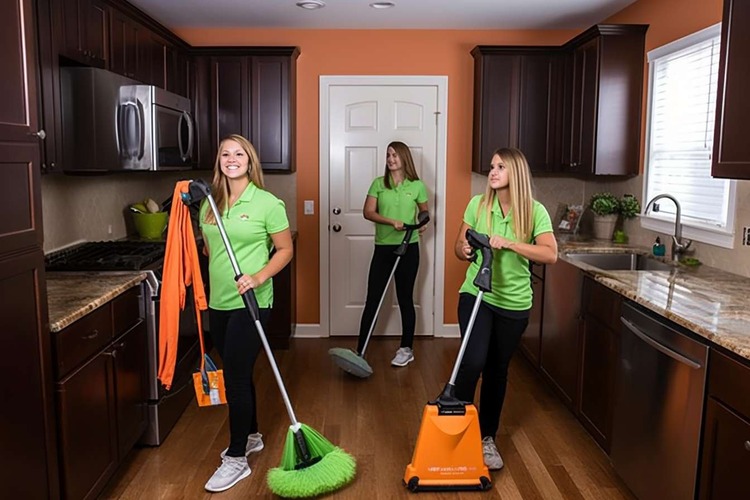Cleaning Services: What to Expect, Types, and Quality Tips
A clean space does more than look good—it can boost focus, improve comfort, and protect surfaces and fixtures over time. Whether you’re considering a one-time deep clean or recurring help for a busy household or office, understanding how professional cleaning services work will help you choose confidently. Below is a clear, practical guide to common service types, what’s typically included, and how to evaluate quality from local services in your area.

What do cleaning services include?
Most providers offer several tiers. Standard/residential cleaning often covers dusting, vacuuming and mopping, wiping down surfaces, bathroom sanitizing (sinks, toilets, showers), and kitchen cleaning (exteriors of appliances, counters, sink). Deep cleaning goes further—baseboards, vents, inside cabinets (when requested), grout detail, light fixtures, and more time-intensive scrubbing to remove built-up grime. Move-in/move-out cleaning typically includes inside appliances and cabinets, interior windows, and attention to details that help a property feel “new.”
Commercial and office cleaning services may add trash removal, touchpoint disinfection (doorknobs, switches), breakroom and restroom maintenance, and floor care programs tailored to foot traffic and surface type. Many businesses also provide add‑ons like carpet shampooing, upholstery cleaning, or post-construction cleanup. Always ask for a written checklist so you know what’s included by default versus what counts as an extra.
Choosing local services in your area
Selecting a reliable provider starts with transparency. Look for clear service descriptions, estimated time on site, and whether the company brings its own supplies and equipment. Reputable teams typically complete background checks for staff, provide proof of liability insurance and workers’ compensation, and have consistent quality control processes (such as supervisor spot checks or follow-up surveys). Online reviews are helpful when they reference specifics—punctuality, consistency, responsiveness, and how the team handled issues.
Consider flexibility, too. Can you customize rooms or prioritize tasks? Do they offer the same team each visit for continuity? For apartments or multi-tenant buildings, check any building requirements (COI—certificate of insurance, front desk policies). If you need evening or weekend cleaning, confirm off-hour availability and any related surcharges.
How often should you book cleaners?
Frequency depends on your space, lifestyle, and tolerance for clutter or dust. Many households choose biweekly standard cleaning to keep surfaces under control, scheduling a deep clean quarterly or before/after special events. Families with pets, allergy sensitivities, or heavy kitchen use may prefer weekly visits. Single-occupancy homes might be well served by monthly cleaning with a seasonal deep clean.
Offices typically match cleaning cadence to foot traffic. Small offices may need two to three visits per week for trash removal, touchpoint wipe-downs, and restrooms; high-traffic spaces, medical-adjacent offices, and retail often require daily service. For any cadence, define your top priorities—bathrooms, kitchen, floors—and ensure they’re included every visit, with rotational tasks (e.g., blinds, baseboards) planned at set intervals.
Eco-friendly and safe practices
Green cleaning has evolved beyond buzzwords. Many providers now offer plant-based or low-VOC products, microfiber systems that trap dust more effectively, and HEPA-filter vacuums that reduce fine particles in the air. If you have infants, pets, or sensitivities, ask for Safety Data Sheets (SDS) on products and request fragrance-free options where possible. For kitchens and bathrooms, ensure disinfectants meet established efficacy standards for the microorganisms you’re concerned about, and confirm proper dwell time (the period a disinfectant must remain wet on a surface to work).
This article is for informational purposes only and should not be considered medical advice. Please consult a qualified healthcare professional for personalized guidance and treatment.
What defines quality in cleaning?
Strong providers set expectations up front with a detailed scope, then measure results. A good quality program includes:
-
A standardized checklist tailored to your space.
-
Training and supervision for staff.
-
Color-coded cloths and tools to avoid cross-contamination (e.g., different colors for bathrooms vs. kitchens).
-
HEPA filtration for vacuuming and regular maintenance of equipment.
-
Clear communication channels for feedback and fast issue resolution.
Ask about satisfaction guarantees. Many companies offer to re-clean missed items within a set window if you report issues promptly. Photos of completed work, before/after documentation for deep cleans, or periodic walk-throughs can also demonstrate consistency.
Preparing your space for a better clean
A few simple steps can help cleaners focus on what matters most. Tidy surfaces by putting away personal items and dishes, secure valuables, and provide access instructions (gate codes, keys, parking). Share any “do not touch” areas and note material-specific concerns (e.g., marble counters needing pH-neutral products). For office settings, coordinate timing to minimize disruptions and ensure trash, recycling, and shredding policies are clear.
If you’re scheduling a deep clean, consider sequencing: declutter first, then clean; if you’re planning painting or repairs, arrange cleaning after those tasks to remove dust and residue. For move-out cleanings, make sure utilities are on and appliances are emptied and defrosted (if needed) so teams can work efficiently.
Hygiene versus disinfection: knowing the difference
Routine cleaning removes soil and many germs from surfaces, while disinfection uses EPA- or regionally approved products to kill specific pathogens on nonporous surfaces when used according to label directions. Not every area needs frequent disinfection; overuse can damage finishes and isn’t always necessary for low-touch surfaces. High-touch points (handles, switches, faucets, railings) benefit from more frequent attention, particularly in shared spaces. If you’re concerned about specific risks, discuss a targeted plan rather than blanket disinfection that may waste time and product.
Understanding scope limits and specialty work
Typical cleaning services do not include mold remediation, biohazard cleanup, exterior window work for high rises, or tasks requiring ladders beyond a safe height without special equipment. Oven or fridge interiors, inside cabinets, and carpet extraction are often add-ons. Clarify these distinctions ahead of time and request specialty vendors when the job calls for restoration-level skill (e.g., after a leak, smoke damage, or construction dust). Your provider may have vetted partners for these situations.
Digital conveniences that improve the experience
Modern cleaning companies increasingly offer online booking, in-app scheduling, secure payment, and visit notes with photos. Automated reminders reduce missed appointments, while client portals keep your preferences on file. If you manage multiple locations, ask about consolidated billing and reporting to track service cadence, special projects, and quality metrics.
Setting expectations for long-term success
A successful cleaning relationship is built on clarity and consistency. Start with a candid walkthrough, define must-do tasks and nice-to-haves, and agree on frequency and scope. Share feedback early—ideally after the first two or three visits—so the team can adjust. Over time, plan seasonal tasks like interior windows, appliance interiors, or grout refreshes to preserve the look and lifespan of your surfaces. With the right provider and clear communication, cleaning services can shift from a reactive chore to a proactive part of maintaining a healthy, welcoming environment.






